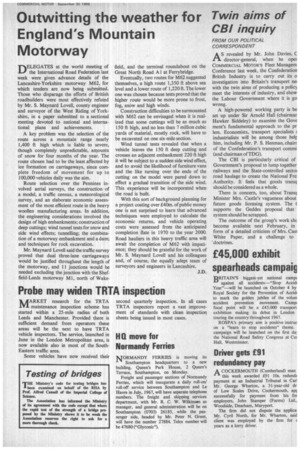Outwitting the weather for Twin aims of England's Mountain CBI inquiry
Page 53

If you've noticed an error in this article please click here to report it so we can fix it.
FROM OUR POLITICAL
Motorway CORRESPONDENT AS revealed by Mr. John Davies, C DELEGATES at the world meeting of the International Road Federation last week were given advance details of the Lancashire-Yorkshire motorway M62, for which tenders are now being submitted. Those who disparage the efforts of British roadbuilders were most effectively refuted by Mr. S. Maynard Lovell, county engineer and surveyor of the West Riding of Yorkshire, in a paper submitted to a sectional meeting devoted to national and international plans and achievements.
A key problem was the selection of the route across a mountain range nearly 1,400 ft high which is liable to severe, though completely unpredictable, amounts of snow for four months of the year. The route chosen had to be the least affected by ice formation on carriageways, since complete freedom of movement for up to 100,000 vehicles daily was the aim.
Route selection over the Pennines involved aerial surveys, the construction of a model, a traffic census, a meteorological survey, and an elaborate economic assessment of the most efficient route in the heavy woollen manufacturing areas. In addition, the engineering considerations involved the design of high embankments; construction of deep cuttings; wind tunnel tests for snow and side wind effects; tunnelling; the combination of a motorway embankment and a dam; and techniques for rock excavation.
Mr. Maynard Lovell said the traffic survey proved that dual three-lane carriageways would be justified throughout the length of the motorway, and II junctions would he needed excluding the junction with the Sheffield-Leeds motorway Ml, north of Wake field, and the terminal roundabout on the Great North Road Al at Ferrybridge.
Eventually, two routes for M62 suggested themselves, a high route 1,350 ft above sea level and a lower route of 1,220 ft. The lower one was chosen because tests proved that the higher route would be more prone to frost, fog, snOw and high winds.
Construction difficulties to be surmounted with M62 can be envisaged when it is realized that some cuttings will be as much as 150 ft high, and no less than 7 million cubic yards of material, mostly rock, will have to be excavated on one six-mile section.
Wind tunnel tests revealed that when a vehicle leaves the 150 ft deep cutting and crosses an adjacent embankment 220 ft high it will be subject to a sudden side wind effect, and to avoid the likelihood of furniture vans and the like turning over the ends of the cutting on the model were pared down to effect a gradual transition of the side wind. This experience will be incorporated when the road is built.
With this sort of background planning for a project costing over £40m. of public money one is not surprised to learn that advanced techniques were employed to calculate the economic returns, and vehicle operating costs were assessed from the anticipated completion date in 1970 to the year 2000. Road hauliers in this heavy traffic area will await the completion of M62 with impatience; they should be grateful for the work of Mr. S. Maynard Lovell and his colleagues and, of course, the equally adept team of surveyors and engineers in Lancashire. director-general, when he °per COMMERCIAL MOTOR'S Fleet Managem Conference last week, the Confederation British Industry is to carry out its o investigation into Britain's transport no with the twin aims of producing a policy meet the interests of industry, and show the Labour Government where it is go wrong.
A high-powered working party is be set up under Sir Arnold Hall (chairmar Hawker Siddeley) to examine the Gave ment's fundamental approach to the pr tern. Economists, transport specialists k• industrialists will be among those helr him, including Mr. P. S. Henman, chairr of the Confederation's transport commi (and chairman of TDG).
The CBI is particularly critical of Government's proposal to lump together railways and the State-controlled secto road haulage to create the National Frei Authority. It feels that goods transj should be considered as a whole.
There is concern, too, about Trans! Minister Mrs. Castle's vagueness about future goods licensing system. The ( supports the Geddes proposal that system should be scrapped.
The outcome of the group's work shc become available next February, in form of a detailed criticism of Mrs. Casi White Paper, and a challenge to 'doctrines.
















































































































































































































